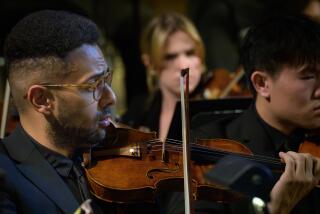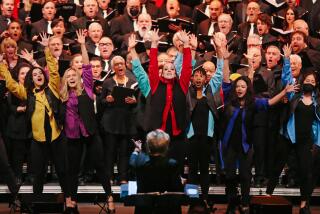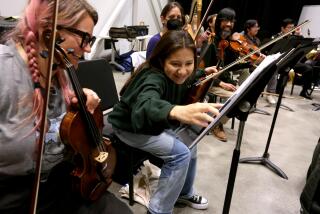Well-Respected Traditions of St. Olaf Choir
- Share via
When the St. Olaf Choir returns to Dorothy Chandler Pavilion tonight after a five-year absence, the group’s visual image may be something of a surprise to first-timers in the audience.
The young singers from Minnesota will carry no music on stage with them, and before a note is sung, each will grasp the hand of the person on either side of himself.
Initiates will soon discover that this chorus sings most of its repertory from memory, that it specializes in a cappella arrangements, and that it clasps hands at all times when music is not being held.
On the phone from Phoenix, conductor Kenneth Jennings emphasizes the respect for tradition and continuity at St. Olaf College, proud parent institution of the internationally renowned chorus. Jennings, only the third director in the group’s 78-year existence, retires in 1990, concluding a tenure of 22 years--the shortest of the three to date.
The conductor professes himself not entirely at ease with all the famous St. Olaf traditions: “I have no idea when or why the hand-holding custom began. We didn’t do it when I was a student in the choir. Well, maybe the girls held hands down front and I was unaware, but the boys certainly didn’t. I was very surprised to find the boys holding hands, too, but now it’s traditional.”
The director’s older-generation discomfort is definitely not shared by his youthful charges, who maintain that clasping hands during performance creates an experience of solidarity and unity, both musical and spiritual.
The spiritual is an inextricable element of life at the school, musical and otherwise. Founded in 1874 by Norwegian immigrants at Northfield, Minn., as a Lutheran Volksschule, St. Olaf received its college charter in 1889.
The chorus, originally an amalgam of college students and local church choir singers, officially became the St. Olaf Choir in 1911. Founding director F. Melius Christiansen held the post until 1941, passing it on to his son, Olaf. Alumnus Jennings joined the faculty in 1953 and succeeded Olaf Christiansen in 1968.
“The choir has had an unquestionable influence on college choirs in general. We were the first to tour, starting in 1912 just in our own state and Wisconsin. But in 1920 F. Melius took the bit and went to the East Coast. The choir was a sensation at the Metropolitan Opera House, and was in demand from there on.
“I brought in more contemporary music--we just gave the Midwest premiere of Dominick Argento’s ‘Te Deum’ in October--and more early music, too, more Palestrina in addition to the Lutherans (Bach, Schutz). Also, we expanded into larger works as well. For instance, on this tour we are doing a Mozart Mass (in B-flat) with small orchestra. That wouldn’t have been done under Olaf Christiansen.
“The original ideals haven’t changed. We still produce what some call a Northern European sound, closely in tune, unisons as nearly perfect as possible. The singers are all undergraduates and we stay right with the style of what students can do at this age. If we had graduate students, or singers with more developed voices, it might be different, but we are traditionally identified as a youthful sound.”
In Jennings’ time, the choir has toured Europe and the Orient, represented the United States at the 1988 Seoul Olympic Arts Festival and Protestantism at the Vatican’s 1975 “Christian Unity Week.” The conductor’s advice to his unnamed successor?
“Just enjoy it thoroughly. It’s a marvelous experience working with such talented young people.”
More to Read
The biggest entertainment stories
Get our big stories about Hollywood, film, television, music, arts, culture and more right in your inbox as soon as they publish.
You may occasionally receive promotional content from the Los Angeles Times.










